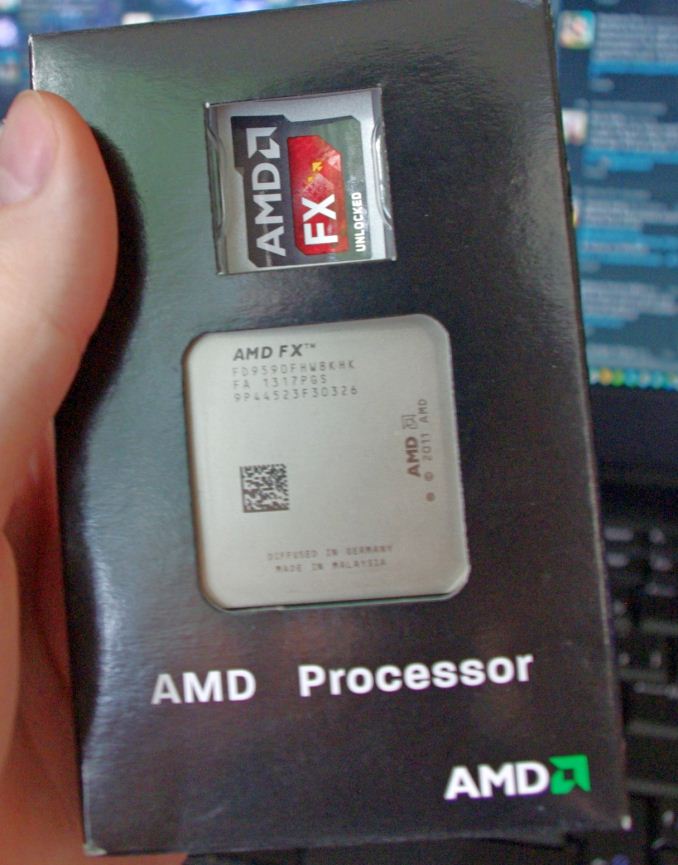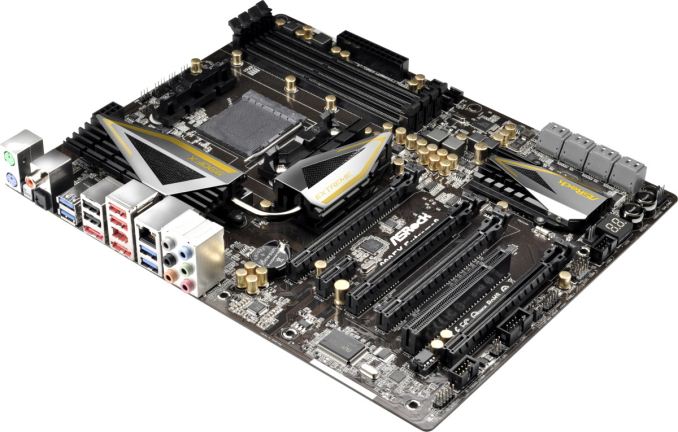AMD’s 5 GHz Turbo CPU in Retail: The FX-9590 and ASRock 990FX Extreme9 Review
by Ian Cutress on August 9, 2014 8:00 AM ESTThe AMD FX-9590
The analysis in this review shows that even a year after the OEM release of the FX-9590, and almost two years from the architecture coming to market it remains AMD’s performance part. If power consumption is not a concern, as a CPU compute and an AMD gaming CPU (especially when considering SLI) the FX-9590 is the best choice at stock speeds. On that basis alone, it makes sense that AMD should actually release it as a retail part, assuming they have enough stock. One might argue that a user could buy an FX-8350 and overclock, but if our sample CPUs were anything to go by, a user needs a fair bit of luck. The FX-9590 guarantees a 5.0 GHz turbo with a warranty.
With the retail release of the CPU, that warranty might be based on using the water cooling provided for the lifetime of the CPU. One might argue that AMD had trouble finding enough dies that could reach the frequencies and voltages for the FX-9590, and hence the delay combined with selling the SKU in select markets only.
The FX-9590 is the same Piledriver architecture as the FX-8350, which in turn was used in the A10-5800K/A10-6800K APUs, codename ‘Trinity’ and ‘Richland’ respectively. Since then, AMD has launched the Steamroller architecture modifications in the form of Kaveri APUs. The difference between a PIledriver APU and a similar frequency Steamroller APU, if we put aside the move from 32nm SOI to 28nm SHP, is around 10% for CPU performance. If that was shifted into a four-module, eight-thread CPU, it would surely be AMD’s performance part. The issue here is that AMD has almost discarded the high CPU performance arena in favor of integrated graphics. From Trinity to Kaveri, the IGP inside those APUs has improved considerably, indicating where AMD is investing its research dollars.
AMD clearly still cares about the performance market, otherwise this retail FX-9590 with water cooling would have never been pushed through to retailers. The high power consumption, the lack of a modern chipset, and the comparison to Intel CPUs in single threaded benchmarks are the main barriers to adoption. If AMD is to return to the performance market, the power consumption has to be comparable to Intel, or if it is slightly higher, the chipset has to offer something Intel cannot. Any suggestions for what that feature should be should be submitted on a postcard/in the comments.
ASRock 990FX Extreme9 Conclusion
One of the big issues surrounding AMD motherboards is their price sensitive nature. With an Intel based product, a $250-$400 motherboard is common enough to signify the expense in research or extra features. Because the AMD ecosystem, even in the high performance segment, is a cost sensitive market there is little room to move. For example, this year sees the first overclocking based motherboard for AMD APUs since the AM3+ era. So at $170, the Extreme9 could arguably be described as ‘limited’ compared to Intel standards.
The motherboard itself has specified support for 220W CPUs, something other motherboards either fail to mention or advise against completely. The native SATA 6 Gbps ports were ahead of Intel at the time, plus ASRock adds in another SATA 6 Gbps controller for good measure.
The eight USB 3.0 ports makes the Extreme9 have more USB 3.0 ports than almost every other 990FX/AM3+ motherboard ever released. This is combined with plenty of legacy support, such as separate PS/2 connectors, a PCI slot, an IEEE1394 port and an IEEE1394 header. The Intel NIC is paired with a Realtek ALC898 codec, with the PCIe layout aimed at 3-way GPU users for both Crossfire and SLI.
Aside from an updated chipset, if we were building a high-end AM3+ motherboard in 2014, I would insist on WiFi support and an upgraded audio codec to the ALC1150 at the minimum. We cannot get around the lack of PCIe 3.0 support, although moving the CPU modules from Piledriver to Steamroller along with the IO support might help with that. If we are being greedy with what we would like, I would add in M.2 support as well.
There is plenty to speculate if AMD had kept updating their high-end performance CPU line, even if the socket was not updated. As it stands, users who want SLI either look back to 990FX or invest in Intel. Users who want high multithreaded CPU performance either look back to 990FX or invest in Intel. Users who do not want processor graphics either look back to 990FX, buy an APU with the graphics disabled, or invest in Intel. AMD clearly does care about the performance market, or at least someone senior in the company does.












146 Comments
View All Comments
RussianSensation - Sunday, August 10, 2014 - link
The motherboard in the review is $170 not $250. But yes it's a lot better to buy an i5-7 than this chip.edwd2 - Saturday, August 9, 2014 - link
Will we be getting new FX chips in the future?or is it just APUs ...
Mrduder11 - Saturday, August 9, 2014 - link
I am not highly invested in either "camp" but I will say this is absolutely embarrassing for AMD. As a gamer, I could never justify purchasing this CPU when using with a dedicated graphics setup. The results show AMD's way off the mark in research and development in their GPU labs.RussianSensation - Sunday, August 10, 2014 - link
Has little to do with research and development. You can't expect a 28-32nm CPU to compete with a 22nm CPU no matter how hard you try. It would be akin to NV having 28nm GTX780Ti going up against a 40nm HD6970. AMD's biggest problem is no access to the same lithography tech as Intel.mapesdhs - Tuesday, August 12, 2014 - link
Actually it has a lot to do with R&D. An ex-AMD employee said a few years ago thatAMD's big mistake was making extensive use of automated design tools, resulting
in a 3rd more transistors, using more power, for less performance. Presumably this
was cheaper than paying the required talent to do the fine tuning normally expected
at this level. Either way, this is why BD was so bad, and they've never recovered.
AMD simply doesn't have the money to do the base R&D, that's the key blockage.
Ian.
Budburnicus - Wednesday, January 14, 2015 - link
Umm, the i5-2500k AND i7-2600K are 32nm CPU's and even at a 4.7 GHz overclock do not even draw HALF the power and are over TWICE as fast! All from a 3 year old SKU!The cherry on top of the pile of dog poop would HAVE to be the fact that AMD had to make an R9 290 with a 512 bit memory bus to TRY to keep up with Nvidia's 970 or 980 - and that GPU takes over twice the power as well!
So YES this has EVERYTHING to do with R&D! Both their CPUs and GPUs are HORRIBLY inefficient!
And again, process has little to do with it, bearing in mind that the 32nm i-cores are not only 3 years old, but draw well less than HALF the power, and still over 1/3 less at the same 4.7 GHz clock speed, except when an i7-2600K is running at that speed, it is FAR FASTER in EVERY way!
TeXWiller - Saturday, August 9, 2014 - link
Who knows, Kaveri brought the three module support for the APUs. The devil is the implementation details and timing. I was little disappointed when they took out the remaining 95W four module chips from the channel.TiGr1982 - Saturday, August 9, 2014 - link
What do you mean by "three module support for the APUs"? Talking about CPU side of things, all the APUs since Trinity only have 2 CPU modules aka 4 AMD cores. More than that, staying with this Bulldozer-derived CPU tech, APUs won't get more than 2 modules because of the die area and associated TDP and cost issues.TeXWiller - Saturday, August 9, 2014 - link
See http://support.amd.com/TechDocs/49125_15h_Models_3... page 28TiGr1982 - Saturday, August 9, 2014 - link
OK,"2 or 3 core-pairs Add 3 CU support."
But there is no 3 "core-pair" (3 CU, 3 modules) Kaveri APUs on the market - at least, as of yet.